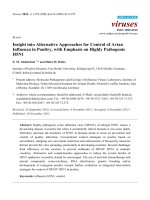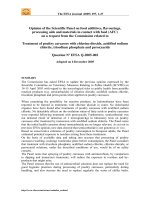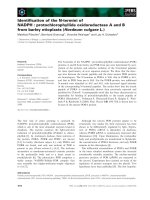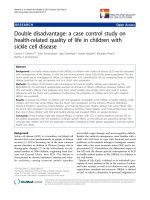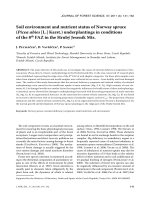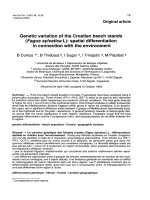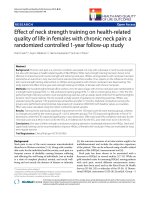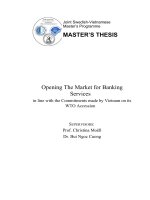Pioneering biotechnological works on Hordeum vulgare L. cvs performed in collaboration with the ‹stanbul university biology department and the Tübitak research institute for genetic
Bạn đang xem bản rút gọn của tài liệu. Xem và tải ngay bản đầy đủ của tài liệu tại đây (74.63 KB, 6 trang )
Turk J Bot
27 (2003) 243-248
â TĩBTAK
Review
Pioneering Biotechnological Works on Hordeum vulgare L. cvs
Performed in Collaboration with the stanbul University Biology
Department and the TĩBTAK Research Institute for Genetic
Engineering and Biotechnology
Nermin GệZĩKIRMIZI
stanbul University, Faculty of Science, Department of Genetics and Molecular Biology, 34459, Vezneciler, stanbul - TURKEY
TĩBTAK, Research Institute for Genetic Engineering and Biotechnology, P.O.Box: 21, 41470, Gebze, Kocaeli - TURKEY
Received: 18.04.2002
Accepted: 24.02.2003
Abstract: Hordeum vulgare L. (barley) is an important cereal crop and is also an excellent model organism for biochemists,
physiologists, geneticists and molecular biologists. H. vulgare cvs. have been used as a model system for almost 30 years at the
Biology Department of stanbul University, stanbul-Turkey. The first studies on experimental mutagenesis were followed by tissue
culture, gene transfers, DNA marker applications and finally DNA arrays which, progressed further after the 1990 when
collaboration was established with the Plant Biotechnology group at the TĩBTAK Research Institute for Genetic Engineering and
Biotechnology in Gebze, Kocaeli-Turkey. This review article outlines the results of original research into Turkish barley cultivars and
wild types with the intention of contributing to barley-breeding programmes with recent biotechnological techniques.
Key Words: barley, mutation, tissue culture, gene transfer, DNA array
stanbul ĩniversitesi Biyoloji Bửlỹmỹ ve TĩBTAK Gen MỹhendisliÔi ve Biyoteknoloji
Arafltrma Enstitỹsỹ flbirliÔi ile Hordeum vulgare L. cvs.de
Gerỗeklefltirilen ệncỹ Biyoteknolojik ầalflmalar
ệzet: Hordeum vulgare L. (arpa) ửnemli bir tahl bitkisidir, biyokimyaclar, fizyologlar, genetikỗiler ve molekỹler biyologlar iỗin ỗok
etkin bir model organizmadr. Hordeum vulgare cvs. yaklaflk 30 yldr stanbul ĩniversitesi Biyoloji Bửlỹmỹndeki genetik temelli
ỗalflmalarda model sistem olarak kullanlmaktadr. lk deneysel mutasyon ỗalflmalar 1990l yllarda TĩBTAK, Gen MỹhendisliÔi ve
Biyoteknoloji Arafltrma Enstitỹsỹ, Bitki Biyoteknolojisi Grubu iflbirliÔi ile doku kỹltỹrỹ, gen transferleri, DNA markr uygulamalar ve
DNA array ỗalflmalar ile sỹrdỹrỹlmỹfltỹr. Bu derleme makalede Tỹrk kỹltỹr ve yabani arpa varyeteleri ile yaplan ửzgỹn ỗalflmalar
arpa yetifltiriciliÔine gỹncel biyoteknolojik yửntemlerle katklar saÔlanmak amac ile ửzetlenmifltir.
Anahtar Sửzcỹkler: arpa, mutasyon, doku kỹltỹrỹ, gen aktarm, molekỹler markrlar, DNA-array
Introduction
Cultivated barley (Hordeum vulgare L.) is the secondmost important cereal crop for Turkey after wheat, and
is consumed as feed for livestock and, food for humans
and, most importantly, is also used for brewing malts.
Barley is also an excellent model plant for biochemists,
physiologists, geneticists and molecular biologists
(Shewry, 1992). According to world statistics, it is
cultivated on 53,827,895 hectares with a 25,723 Hg/Ha
world yield of which Turkeys contribution is 3,550,000
hectares with an 18,592 Hg/Ha yield (FAO, 2001). Barley
is a self-pollinating diploid with 2n = 2x = 14
chromosomes. Moreover, it has two-rowed and sixrowed types, according to spike morphology (Bothmer et
al., 1991). The genome size of barley is 5.5
picogram/haploid nucleus and is equivalent to
approximately 5.3 x 109 bp (Bennet & Smith, 1976), and
50-60% of the genome consists of repeated sequences
(Rimpau et al., 1980). Copia-like retrotransposon BARE1 comprises almost 7% of the barley genome (Manninen
& Schulman, 1993). Ease of growth under laboratory
conditions facilitates the development of molecular
markers for the construction of genetic maps (Williams et
al., 2001). The barley genome project and production of
243
Pioneering Biotechnological Works on Hordeum vulgare L.cvs Performed in Collaboration with the ‹stanbul University Biology Department and the
TÜB‹TAK Research Institute for Genetic Engineering and Biotechnology
barley ESTs are in progress with contributions from
various organisations (Michalek et al., 2002). Recently,
the first functional genomic studies were carried at for
stress tolerance (Öztürk et al., 2002) and tissue-specific
differential expression (Sreenivasulu et al., 2002) in
barley.
The main objective of barley breeding programmes is
mainly to increase yield and grain quality. Improvement
efforts are also concentrated on producing varieties
resistant to biotic (pathogens, fungal, viral and other
organisms) and abiotic stresses (e.g. drought, salt, cold
and heat) (Dunwell, 1986). During conventional breeding
programmes via hybridisations between high-yielding
cultivars and wild barley, specific traits may be
introgressed in back-crossing programmes (Nevo, 1992).
Mutation breeding is also important for widening
variation. Radiation and chemical mutagenesis have been
used to increase the numbers and varieties of barley
which might have desirable traits. For example, one of
the most popular malting barleys, “Golden promise”, was
produced in 1957 using radiation mutagenesis (Milne
Marsters Co., 1970).
Proffessor Emine Bilge performed the first basic
genetic experiments in which barley was used at the
Biology Department of ‹stanbul University in the
framework of the project “Basic Genetic Studies for
Obtaining High Quality Barley Lines’ Grant No.162,
TÜB‹TAK, TOAG. In this study, Zafer 160 barley seeds
were treated before sowing with X and gamma rays,
ethyl alcohol, streptomycin, terramycin, penicillin G,
sodium cyanide and ethylmethane sulphonate solutions.
In addition to chlorophyll deficient types, large-eared,
high-yielding, thick-stemmed, dwarf and early-heading
mutants were obtained in M1 and succeeding generations
of the treated material. As a result of seed irradiation
with 16,000 rad doses of X-rays, a mutant barley called
KA/14 was obtained. The ear shape of this mutant
resembled that of the hooded type, and, the number of
tillers and the yield were higher than the control. After
artificial pollination of Zafer 160 females with 1000 rad
gamma irradiated pollen, short-stemmed and early
mutants appeared in the F2 generation. Their heading
time was 23 days earlier than that of the control. Meiosis
was studied in the anthers, and the following
abnormalities were observed in the treated material:
breaking and sticking together of the chromosomes,
chromatin bridges, translocations, micronucleus
244
formation, spindle splitting and non- synchronised phases
in the second division etc. (Bilge et al., 1981 a,b). The
effects of X and gamma rays on mitotic cell division and
the protein content of the irradiated seeds were also
investigated (Olgun, 1985). The adaptation efficiency and
micro yields of these mutant types were studied in the
framework of “Studies on Agricultural Applications of
Experimental Mutations Induced on Native Barley Variety
Zafer 160” TÜB‹TAK, TOAG Grant No.162.
Mutation studies were continued on two projects, one
of which was supported by TÜB‹TAK-TBAG Grant No.
515 and the other by ‹stanbul University Research
Foundation Grant No. 212/030186, on tissue cultured
material. In the framework of the first project the effects
of pesticides were studied. The effects of two commercial
pesticide preparations, 2,4- dichlorophenoxyacetic acid
isooctylester (2,4-D) and phenylmercury acetate (PMA)
on different organisms were investigated. These reagents
did not produce numerical and structural changes in the
mitotic chromosomes of Hordeum vulgare embryo
cultures (Oraler et al., 1984). In the second project the
effects of X and gamma rays on calli cultures were
studied. Mature embryo parts were used for callus
formation and plant regeneration was achieved on
Murashige-Skoog (MS) medium (Gözük›rm›z› &
Ekmekçiler 1987; Ar› 1994).
Gene transfer technologies offer a suitable alternative
for improving desirable gene(s) in a directed manner
without the undesirable insertion of DNA fragments. The
establishment of stable and regenerative tissue culture
systems is a prerequisite for barley transformation.
Different explants, immature embryos (Breiman, 1985),
mature embryos (Lupotto,1984), apical meristems (Chen
& Smith 1975), anthers (Kao & Horn 1982),
microspores (Köhler & Wenzel 1985), cell suspensions
(Kott & Kasha 1984) and protoplasts (Lazzeri & Lörz
1990) have been used for this purpose.
In 1987, under a grant from NATO-TU-BIOTECH I,
No. 842 in subproject 1.2.2 entitled “Callus Induction,
Plant Regeneration and Chromosomal Variations in
Barley’ callus cultures were induced on mature embryo
mesocotyl explants in Zafer 160 barley. The callus
induction ratio was 54% in MS medium supplemented
with 1 mg/l 2,4- dichlorophenoxyacetic acid (2,4-D).
After transfer at 22, 45, 360 and 540 days of culture to
MS medium, containing lower concentrations of or
lacking 2,4-D, only the 45-day-old- callus showed somatic
N. GÖZÜKIRMIZI
embryogenesis (Fig. 1). Abnormalities in both the
number and structure of chromosomes increased with
the age of the calli. This phenomenon might be related to
the loss of regeneration ability in 540-day-old calli. In
vitro regenerated plantlets gave rise to normal-looking
plants after their transfer to soil. Regenerated plants had
the normal diploid chromosome number in their root tips
(Gözük›rm›z› et al., 1990). Anther and microspore
cultures of the same variety were also established (Ar› et
al., 1992).
Plant transformation was achieved using the
electrophoresis of germinating seeds (Ahokas, 1989) or
the incubation of embryos in a DNA solution (Töpfer et
al., 1989), PEG and electroporation-mediated protoplast
transformation (Junker et al., 1987; Teeri et al., 1989),
microspores electroporation (Joersbo et al., 1990),
particule bombardment (Wan & Lemaux 1994), macroinjections (Mendel et al., 1990) and micro-injections
(Olsen, 1991) in barley.
The Plant Biotechnology Group was organised in
1992 at TÜB‹TAK’s, Marmara Research Centre, and
biotechnological research on barley was supported as a
strategic project untill 2000. Transformation was
performed using both biolistic and tissue electroporation
techniques at TÜB‹TAK laboratories. In general, the
second technology was used successfully for the first time
in the literature (Gürel & Gözük›rm›z›, 2000). This study
was conducted to detect the optimum conditions for DNA
transfer into mature embryos via electroporation.
Cultured mature barley embryos were directly
electroporated in the presence of the pBI 121 vector
carrying both the glucuronidase and neomycin
phosphotransferase genes. It was found that 500 v/cm
and 500 Fd capacitance was the optimum combination
Figure 1.
for the healthy germination of transformed plants from
mature electroporated embryos. Gene transfer
performed on 3-day-old cultures resulted in the highest
germination frequencies. Transgenesis was confirmed by
PCR and Southern hybridisation analyses (Gürel &
Gözük›rm›z›, 2003).
A variety of molecular markers have become available
in recent years (Mohans et al., 1997; Gupta et al., 1999),
and efforts are also being made to identify the most
efficient and cost-effective markers that can be used by
practicing plant breeders. In addition to their use in plant
breeding, molecular markers have been put to several
other uses, including genome mapping (Kleinhofs et al.,
1993; Han et al., 1993), DNA fingerprinting (Faccioli et
al., 1999) and the study of genetic diversity (Baum et al.,
1997).
In 1992, the plant biotechnology group in TÜB‹TAK
started investigating molecular markers using RAPD
techniques. Tissue culture regenerated plantlets were
tested for stability (Gözük›rm›z› et al., 1992), methods
were developed for hybrid selection from wild lines and
cultivars of barley (Hordeum vulgare cvs. Kaya, Quantum,
Tokak, Yerçil and Cumhuriyet) and these hybrids were
characterised by random amplified polymorphic DNA
assay. DNA isolated from parents and F1 hybrids was
amplified using 10 base long primers. Hybrids giving
selective banding patterns from both the cultivars and
wild parents were taken as real hybrids. This technique is
convenient for plant breeders since it is rapid, sensitive
and inexpensive (Ar› et al., 1995). At this time wild type
barleys originating in Turkey were being obtained from
gene banks, and using these seeds a DNA bank was
established and DNA fingerprinting studies were
performed for the first time in Turkey (Gürel &
Gözük›rm›z›, 1998; Albayrak & Gözük›rm›z› 1999).
Tissue culture stages of Zafer 160 barley. (A) Embryogenic callus (B) Somatic
embryo (C) Plantlet regeneration (Gözük›rm›z› et al., 1990).
245
Pioneering Biotechnological Works on Hordeum vulgare L.cvs Performed in Collaboration with the ‹stanbul University Biology Department and the
TÜB‹TAK Research Institute for Genetic Engineering and Biotechnology
In 1997, our group became a partner in the EUREKA1322 Cerealstresstol Project. We aimed to investigate
physiological and molecular markers related to drought
tolerance. We investigated the correlation between the
drought-associated traits of two F2 populations derived
from the crosses made between drought-tolerant and
drought-sensitive barley and wheat parental genotypes.
The parental genotypes of these crosses also differed by
at least three other traits: paraquat tolerance, leaf size
and relative water content. These three traits were
scored in two F2 populations of 80 individuals for each
barley and wheat cross. Analysis of the results indicated
that enhanced tolerance to paraquat correlated with
water stress phenotypes of the drought-tolerant barley
and wheat parents. Our results suggested that selection
based on paraquat tolerance is technically less demanding
and thus useful for rapid screening for enhanced droughttolerance in segregating populations (Alt›nkut et al.,
2001). Using the same material, some promising
drought-related
‘amplified
fragment
length
polymorphisms’ (AFLP) (Alt›nkut et al., 2003) (Fig. 2)
and ‘simple sequence repeats’ (SSRs) markers were also
found, not only in barley (unpublished results), but also in
wheat (Alt›nkut & Gözük›rm›z›, 2003).
Which genes are expressed in different cell types
under different conditions will allow the prediction of
gene expression networks, thereby uncovering the logic
of transcriptional control. Such analyses at the
transcriptional level will be accompanied by similar
analyses at the protein expression level, leading to the
development of an integrated model of cellular gene and
protein expression dynamics. In the new millennium we
aim to establish the DNA array technique and facilities at
the TÜB‹TAK laboratories. To this end one of the PhD.
student’s has joined Proffessor Bohnerts’ group at
Arizona University to learn the technology. During this
project responses to drought and salinity in barley (H.
vulgare cv. Tokak) were for the first time monitored by
the micro-array hybridisation of 1463 DNA elements
derived from cDNA libraries of 6 h and 10 h droughtstressed plants. Functional identities indicated many
cDNAs in these libraries associated with drought stress.
Approximately 38% of the transcripts were novel and
functionally unknown. Hybridisation experiments were
analysed for drought- and salinity-regulated sequences. A
significant change was defined as a deviation from the
control exceeding 2.5-fold. Transcript responses showed
stress-dependent expression patterns and time courses.
Nearly 15% of all transcripts were either up- or downregulated under drought stress, while NaCl led to changes
in 5% of the transcripts (24 h, 150 mM NaCl). The
transcripts that showed significant up-regulation under
drought stress were exemplified by jasmonateresponsive, metallothionein-like, late-embryogenesisabundant (LEA) and ABA-responsive proteins. The most
drastic down- regulation was observed for the
photosynthesis-related function category. Up-regulation
under both drought and salt stress was restricted to ESTs
for metallothionein-like and LEA proteins, while increases
in ubiquitin-related transcripts characterised salt stress. A
number of functionally unknown transcripts from cDNA
libraries of drought-stressed plants showed up-regulation
by drought but down-regulation by salt stress,
demonstrating how precisely transcript profiles describe
different growth conditions and environments (Öztürk et
al., 2002).
170 bp
Figure 2.
246
Amplification of drought-related AFLP markers on 6% polyacrylamide gel containing 7.5 M urea. 1-10 bp ladder, amplification from
sensitive parent ST5819 (2), tolerant parent Tokak (3), tolerant bulk (4), sensitive bulk (5). 6-12: tolerant F2 individuals, 13-19:
sensitive F2 individuals. AFLP marker is indicated with an arrow (Altinkut et al., 2003).
N. GệZĩKIRMIZI
Except for the last data, all the investigations were
carried out using facilities in Turkey. At the moment we
are investigating stress tolerance markers using both
molecular markers, in situ hybridisation and cDNA-AFLP
profile technologies, in the framework of the grants from
stanbul University Research Foundation Grant No.1676.
With regard to barley as a model organism we always
tried to keep up with recent applications. One MSc and
five PhD theses were completed as part of these
investigations, and one more is still continuing. The
valuable contributions by these scientists comprise the
majority of the articles cited in the references. While
carrying out the studies mentioned above we were in
close collaboration with agricultural faculties and
agricultural research institutions all over the country.
Their contributions are gratefully acknowledged,
especially with regard to the selection of materials and
field test experiments. Future measures for the next 10
years will most probably be at the protein level. A
proteomic assay was recently announced on rice
(Salekdeh et al., 2002) under stress conditions. Protein
arrays, proteomics investigations and metabolomics
will become involved not only for improvement studies
but also for product safety analyses for GMO (genetically
modified organisms) barleys. The methods developed
during these studies could easily be adapted to other
important plant species with the intention of
understanding how to manipulate plant genomes
successfully, which will be one of the main milestones of
the 21st century.
This review article is a tribute to the memory of Prof.
Emine Bilge (1926-1978) my former PhD supervisor.
She was a great scientist and mentor who contributed
with unfailing dedication to the development of genetic
applications in plant breeding. She has always been with
us in our hearts and minds over the last 25 years of
research on barley genetics and biotechnology.
References
Ahokas H (1989). Transfection of germinating barley seed
electrophoretically with exogenous DNA. Theor Appl Genet 77:
469-472.
Albayrak G & Gửzỹkrmz N (1999). RAPD Analysis of genetic
variations in barley. Tr J of Agriculture and Forestry 23: 627630.
Altnkut A, Kazan K, pekỗi Z & Gửzỹkrmz N (2001). Tolerance to
paraquat is correlated with the traits associated with water stress
tolerance in segregation F2 populations of barley and wheat.
Euphytica 121: 81-86.
Altnkut A & Gửzỹkrmz N (2003). Search for microsatellite markers
associated with water stress tolerance in wheat through bulked
segregant analysis. Molecular Biotechnology 23: 97-106.
Altnkut A, Kazan K & Gửzỹkrmz N (2003). Detection of AFLP
polymorphism between water stress tolerant and sensitive bulks
constituted based on traits associated with water stress tolerance
in barley. Genetics & Molecular Biology 26(1): 77-82.
Baum BR, Nevo E, Johnson DA & Beiles A (1997). Genetic diversity in
wild barley (Hordeum spontaneum Koch) in the Near East: A
molecular analysis using random amplified polymorphic DNA
(RAPD). Genetic Resources and Crop Evaluation 44: 147-157.
Bennet MD & Smith LB (1976). Nuclear DNA amounts in angiosperms.
Philosophical transactions of the Royal Society (London).
Biological Sciences 274: 227-274.
Bilge E, Oraler G, Gửzỹkrmz N, Olgun A & Topaktafl M (1981a).
Experimental mutations in barley (Hordeum vulgare L.). stanbul
ĩniv Fen Fak Mec Seri B 46: 29-35.
Bilge E, Oraler G, Gửzỹkrmz N, Olgun A & Topaktafl M (1981b).
Cytogenetic studies on Hordeum vulgare L. treated with
mutagens. stanbul ĩniv Fen Fak Mec Seri B 46: 37-42.
Bothmer R, Jacobsen CB, Jorgensen RB & Linde Laursen IB (1992). An
ecogeographical study of the genus Hordeum, systematic and
ecogeographical studies on crop gene pools 7. International Board
for Plant Genetic Resources, Rome.
Ar fi (1994). Effects of radiation on callus cultures in barley. DOA-Tr
J of Biology 18: 149-154.
Breiman A (1985). Plant regeneration from Hordeum spontaneum and
Hordeum bulbosum immature embryo-derived calli. Plant Cell
Rep 4: 70-73.
Ar fi, Bilgen G, ầobanoÔlu G, Gỹrel F & Gửzỹkrmz N (1995).
Determination of barley hybrids with molecular markers. Cereal
Research Communications 23(3): 229-234.
Cheng TY & Smith HH (1975). Organogenesis from callus culture of
Hordeum vulgare. Planta 123: 307-310.
Ar fi, Gỹrel F & Gửzỹkrmz N (1992). Anther and microspore culture
of Hordeum vulgare cv. Zafer-160. Proceedings of Asia Pacific
Conference on Agricultural Biotechnology, 20-24 August 1992,
China Science and Technology Press 536-547.
Dunwell JM (1986). Barley. In: Evans DA, Sharp R & Ammirato PV
(eds). Handbook of Plant Cell Culture Vol. 4: 339-369. London:
MacMillan & Co.
Faccioli P, Pecchioni N, Stanca AM & Terzi V (1999). Amplified
fragment length polymorphism markers for barley malt
fingerprinting. J Cereal Science 29: 257-260.
247
Pioneering Biotechnological Works on Hordeum vulgare L.cvs Performed in Collaboration with the stanbul University Biology Department and the
TĩBTAK Research Institute for Genetic Engineering and Biotechnology
FAO (2001). ./page/collections.
Gửzỹkrmz N, Ar fi, Oraler G, Okatan Y & ĩnsal N (1990). Callus
induction, plant regeneration and chromosomal variations in
barley. Acta Bot Neerl 39: 379-387.
Gửzỹkrmz N, Ar fi, Gỹrel F, Gỹmỹflel F & ầrakoÔlu B (1992).
Fingerprinting barley genome using PCR with arbitrary primers in
barley regenerated from tissue culture. agricultural
biotechnology. Proceedings of the Asia Pacific Conference on
Agricultural Biotechnology, 20-24 August 1992, China Science
and Technology Press, 143-146.
Gửzỹkrmz N & Ekmekỗiler fi (1987). Tissue culture initiation and
plant regeneration in barley Hordeum vulgare. Istanbul Univ Fen
Fak Mec Seri B 52: 69-74.
Gỹrel F & Gửzỹkrmz N (1998). RAPD polymorphism between wild
lines of barley (Hordeum vulgare L.) originated from Turkey.
Genetics and Breeding (1-4): 19-23.
Gỹrel F & Gửzỹkrmz N (2000). Optimization of gene transfer into
barley (Hordeum vulgare L.) mature embryos by tissue
electroporation. Plant Cell Reports 19: 787-791.
Gỹrel F & Gửzỹkrmz N (2003). Electroporation transformation of
barley. In: Jackson JF Liskens HS & Vnman RB (eds). Modern
Methods of Plant Analysis. Vol. 23 Plant Transformation Chapter
5, pp 69-89.
Han F & Ullrich SE (1993). Mapping of quantitative trait loci associated
with malting quality in barley. Barley Genetics Newsletter 23: 8497.
Junker B, Zimmy J, Lỹhrs R & Lửrz H (1987). Transient expression of
chimeric genes in dividing and non-dividing cereal protoplasts
after PEG induced DNA uptake. Plant Cell Rep 6: 329-332.
Kao KN & Horn DC (1982). A method for induction of pollen plants in
barley In: Fujivara A (ed). Plant Tissue Culture, Tokyo: Maruzen,
pp 529-530.
Kleinhofs A, Kilian A & Kudrna D (1993). The NABGMP Steptoe x
Morex mapping progress report. Barley Genetics Newsletter 23:
79-82.
Kott LS & Kasha KJ (1984). Initiation and morphological development
of somatic embryoids from barley cell cultures. Canad J of Bot
62: 1245-1249.
Kửhler F & Wenzel G (1985). Regeneration of isolated barley
microspores in conditioned media and trials to characterize the
responsible factor. J Plant Physiol 121: 181-191.
Lazzeri PA & Lửrz H (1990). Regenerable suspension and protoplast
cultures of barley and stable transformation via DNA uptake into
protoplasts. In: Lycett GW, Grierson D (eds). Genetics Engineering
of Crop Plant. London: Butterworths, pp 231-237.
248
Lupotto E (1984). Callus induction and plant regeneration from barley
mature embryos. Ann Bot 54: 523-529.
Manninen I & Schulman AH (1993). BARE 1, A copia-like retroelement
in barley (Hordeum vulgare L.). Plant Mol Biol 22: 829-846.
Michalec W, Weschke W, Pleissner KD & Graner A (2002). EST analysis
in barley defines a unigene set comprising 4000 genes. TAG 104:
97-103.
Nevo E (1992). Origin, evolution , population genetics and resources for
breeding of wild barley, Hordeum Spontaneum, in the fertile
cresent. In: Shewry PR (ed). Barley: Genetics, Biochemistry,
Molecular Biology and Biotechnology. Oxford: The Alden Press,
CAB International, pp 19-43.
Olgun A (1985). Effects of X and gamma rays on the mitotic cell division
and the protein content at the root tips of Hordeum vulgare L.
stanbul ĩniv Fen Fak Mec Seri B 50: 45-59.
Oraler G, Gửzỹkrmz N & Olgun A (1984). mutagenetic effects of some
pesticides in different organisms. DoÔa Bilim Dergisi Seri A2 8(1):
105-114.
ệztỹrk NZ, Talame V, Deyholos M, Michalowski CB, Galbraith DW,
Gozukirmizi N, Tuberosa H & Bohnert H (2002). Monitoring
large-scale changes in transcript abundance in drought and saltstressed barley. Plant Mol Biol 48(5-6): 551-573.
Rimpau I, Smith DB & Flavel RB (1980). Sequence organization in
barley and oats chromosomes revealed by interspecies DNA/DNA
hybridization. Heredity 44: 131-149.
Salekdeh GH, Siopongco J, Wade LJ, Ghare-Yazie J & Bennett J (2002).
A proteomic approach to analysing drought- and saltresponsiveness in rice. Field Crops Research 76: 199-219.
Shewry PR (1992). Barley: Genetics, Biochemistry, Molecular Biology
and Biochemistry. Oxford: The Alden Press, CAB International.
Sreenivasulu N, Altschmied L, Paintz R, Hahnel U, Michalek W, Weschke
W & Wobus U (2002). Identification of genes specifically
expressed in maternal and filial tissues of barley caryopses: A
cDNA array analysis. Mol Genet Genomics 266: 758-767.
Tửpfer R, Gronenborn B, Schell J & Steinbiss HH (1989). Uptake and
transient expression of chimeric genes in seed-derived embryos.
Plant Cell 1: 133-139.
Technical Brochure (1970). Milne Marsters Company.
